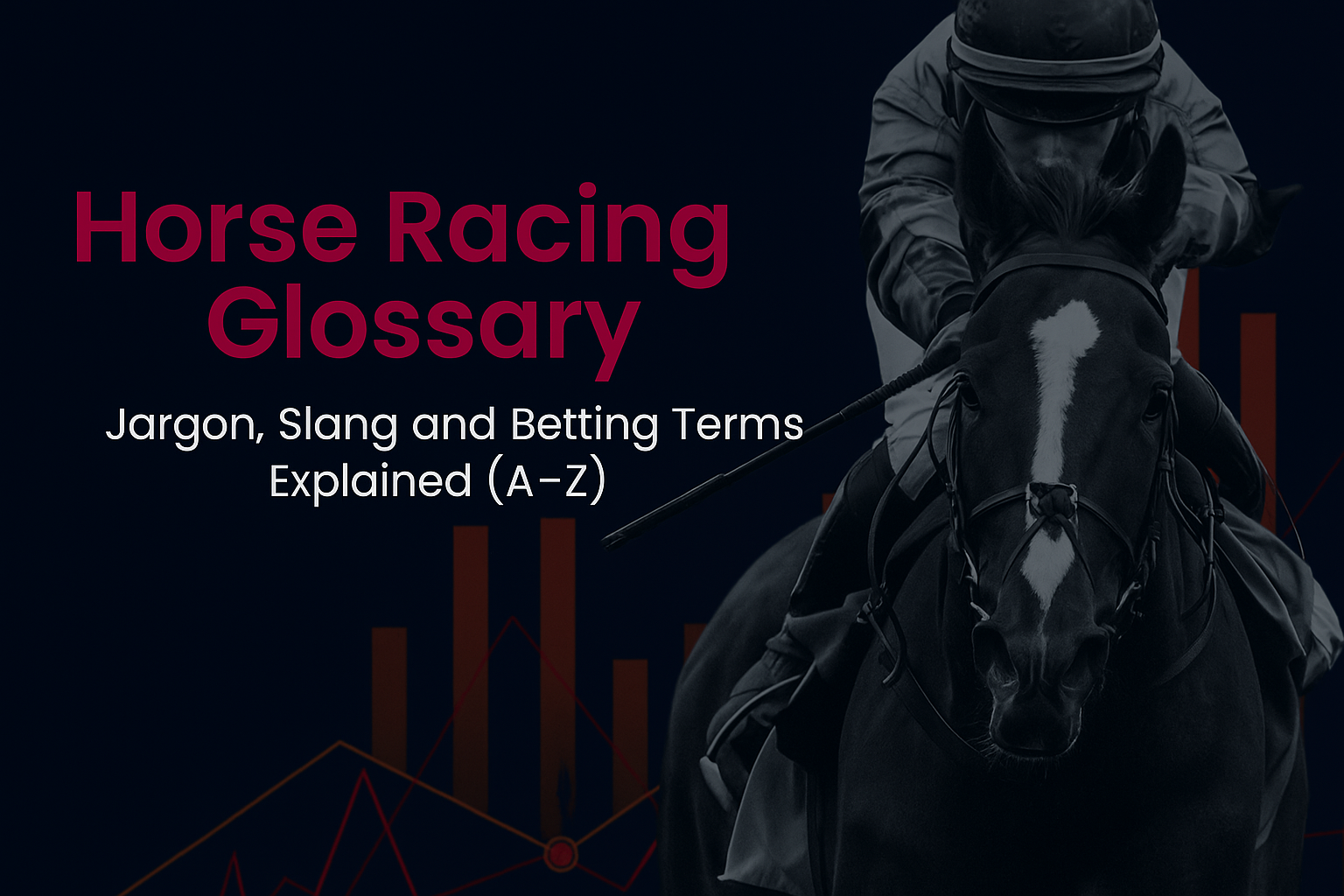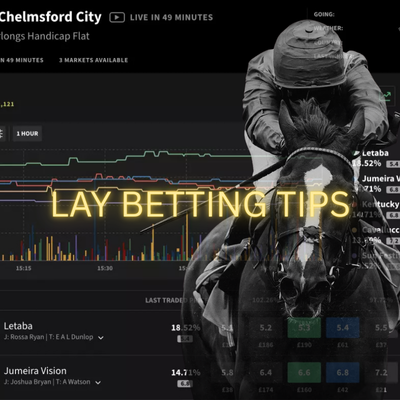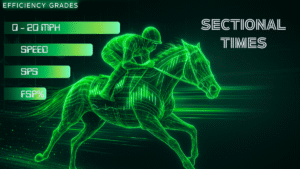Horse Racing Glossary: Jargon, Slang, and Betting Terms Explained (A–Z)
Introduction: Unlock the Language of the Turf
The thrilling world of horse racing is steeped in a rich, unique vocabulary that can feel like a foreign language to newcomers. From the parade ring to the photo finish, every aspect of the sport has its own specific jargon, betting slang, and niche terminology. Without understanding these terms, you might find yourself scratching your head while watching a race, studying form, or trying to place a bet.
That’s where this ultimate A-Z glossary comes in. We’ve meticulously compiled and explained common (and not-so-common) horse racing terms, covering everything from betting lingo and equipment to race types and official roles. Whether you’re a complete novice or just looking to refresh your memory, this guide is your key to confidently navigating the sport of kings.
Use the index below to jump directly to any letter and find the term you’re looking for:
Jump to:
A | B | C | D | E | F | G | H | I | J | K | L | M | N | O | P | Q | R | S | T | U | V | W | X | Y | Z
A
Accumulator – A single multiple bet involving four or more selections from different events. For the bet to win, all individual selections (or “legs”) must be successful. The winnings from each successful leg automatically roll over as the stake for the next.
Example: A £5 accumulator on four horses to win different races. If the first three win, their combined winnings become the stake for the fourth.
All Weather – Refers to flat racing that takes place on artificial, synthetic surfaces (such as Tapeta, Polytrack, or Fibresand). All-weather tracks are designed to be less affected by adverse weather conditions, allowing flat racing to continue year-round, even in winter.
Allowance – A reduction in the weight a horse is required to carry in a race. This is typically granted to:
* Inexperienced Jockeys: Often indicated as a “claim” (e.g., a 7lb claim) for apprentice or conditional jockeys.
* Age/Sex: Some races offer allowances for younger horses or fillies/mares competing against older males in weight-for-age races.
Amateur – A non-professional jockey who does not receive payment for riding. They are often identified on a racecard by their title (Mr, Miss, Ms) before their name.
Ante-Post – A bet placed well in advance of a race’s final declarations, often days, weeks, or even months before the event. Ante-post odds are generally more attractive (higher) than those available closer to the race, but the significant risk is that stakes are typically not refunded if your selection becomes a non-runner. This type of bet is common for major races like the Grand National or Cheltenham Festival.
B
Back – To place a bet on a horse to win or place in a race. This is the opposite of “laying” a horse.
Backward – A term used to describe a horse that is physically immature, still developing, or not yet fully fit and prepared for racing. Such horses may need more time or experience before performing to their full potential.
Banker – A selection (usually a horse) in a bet that is considered almost certain to win. Bankers are often included in multiple bets (like trebles or accumulators) as a foundational leg.
Bar – In a betting market, “Bar” refers to all horses whose odds are longer (higher) than the last horse specifically quoted. For example, “10/1 bar” means every other horse in the race not explicitly listed is priced at 10/1 or greater.
Betting Exchange – An online platform (e.g., Betfair, Smarkets) that allows individuals to bet directly against each other, rather than against a traditional bookmaker. This enables users to “back” (bet on a horse to win) or “lay” (bet on a horse to lose).
Blinkers – A type of headgear fitted to a horse that restricts its side vision. The purpose is to encourage the horse to focus on the race ahead and prevent distraction from other runners or trackside activity. Denoted by a “B” on a racecard.
Bridle – The tack that fits over a horse’s head, consisting of straps, a bit (which goes in the horse’s mouth), and reins. It’s used by the jockey to control and guide the horse. (See also: On the Bridle, Off the Bridle).
Bumper – A flat race run under National Hunt (jump racing) rules. These races are typically for horses that are being prepared for a future career over hurdles or fences, giving them racecourse experience without having to jump obstacles.
C
Cheekpieces – Headgear similar to blinkers, but less restrictive. They consist of sheepskin “cups” that attach to the bridle, partially obscuring the horse’s rear vision to aid concentration. Denoted by a “p” on the racecard.
Claimer – An apprentice jockey (on the Flat) or conditional jockey (in National Hunt) who is entitled to claim a reduction in the weight carried by their horse, due to their inexperience. The size of the “claim” (e.g., 5lb or 7lb) reduces as the jockey rides more winners.
Classic – Refers to one of five prestigious Group 1 flat races held in Great Britain each year for three-year-old horses. These are:
- 2,000 Guineas (for colts and fillies)
- 1,000 Guineas (for fillies only)
- Oaks (for fillies only)
- Derby (for colts and fillies)
- St Leger (for colts and fillies)
Connections – A collective term for all the individuals involved with a particular horse, including the owner(s), trainer, jockey, and sometimes even the stable staff.
Course Specialist – A horse that consistently performs particularly well at a specific racecourse, often showing a preference for its unique track layout, surface, or characteristics.
D
Dam – The mother of a horse. (See also: Sire).
Dead Heat – A rare occurrence when two or more horses finish a race in an absolute tie, with no discernible difference between them even after a photo finish review. In such cases, winning bets are typically settled under “Dead Heat rules,” meaning stakes are divided by the number of horses involved in the tie.
Declared – When a horse is officially confirmed by its trainer to be a runner in a specific race after the final declaration stage.
Distance – Can refer to two things:
- The length of a race (e.g., a 1-mile race, a 2-furlong sprint).
- The margin by which a horse wins or loses a race, measured in lengths, necks, or heads.
Draw – In flat races, this refers to the numbered starting stall (or “gate”) from which a horse begins the race. The draw can be crucial on certain tracks, as some stalls may offer a significant advantage or disadvantage depending on the course’s layout, the distance, and the going.
E
Each-Way – A popular type of bet that is essentially two separate bets:
- One part on the horse to win the race.
- The second part on the horse to place (finish within a certain number of positions, typically 1st, 2nd, 3rd, or 4th, depending on the number of runners and race conditions). If the horse wins, both parts of the bet pay out. If it places but doesn’t win, only the “place” part pays out.
Even Money (Evens) – Odds of 1/1. If you place a £10 bet at Even Money and your horse wins, you get back your original £10 stake plus £10 in winnings, totaling £20.
F
Favourite (Fav) – The horse with the shortest odds (lowest price) in a race, indicating that it is considered most likely to win by the bookmakers and the betting public.
Filly – A female horse aged four years old or younger. (See also: Mare).
Form – A horse’s recent performance history, usually represented as a string of numbers and symbols (e.g., 3124-2) on a racecard. These figures indicate finishing positions, previous wins, and other significant events in its last races, offering insights into its current condition and ability.
Front Runner – A horse whose preferred racing style is to lead the field from the outset or establish a prominent position early in the race.
Furlong – A unit of distance commonly used in horse racing, equal to 220 yards (one-eighth of a mile). Eight furlongs make up one mile.
G
Gelding – A castrated male horse. Geldings are often preferred by trainers and owners as they tend to be calmer, more manageable, and less prone to the behavioural distractions of uncastrated males (colts and stallions).
Going – Refers to the official condition of the racecourse surface. This is a crucial factor as horses often have preferences for certain types of ground. Common descriptions range from:
- Firm (very fast ground)
- Good to Firm
- Good (ideal, balanced ground)
- Good to Soft
- Soft
- Heavy (very slow, tiring ground)
Graded/Group Race – The highest quality and most prestigious races in horse racing.
- Group Races: Apply to Flat racing (e.g., Group 1, Group 2, Group 3). Group 1 races are the elite level.
- Graded Races: Apply to National Hunt (jump) racing (e.g., Grade 1, Grade 2, Grade 3). Grade 1 races are the pinnacle of jump racing.
H
Handicap – A type of race in which horses are assigned different weights to carry, based on their official rating and past performance. The aim is to create a level playing field, giving every horse (in theory) an equal chance of winning by compensating for differences in ability.
Handicapper – The official responsible for assigning a numerical “rating” to each horse and allocating the weights they must carry in handicap races. Their job is to assess each horse’s ability as accurately as possible.
Hurdle – An obstacle used in National Hunt racing. Hurdles are smaller and less substantial than fences, designed to be knocked over if hit by a horse.
Held Up – A riding tactic where the jockey intentionally restrains their horse near the rear or middle of the field during the early stages of a race, saving its energy for a strong finishing effort.
I
In-Running – Refers to live betting and events that unfold during the actual running of a race. In-running betting allows punters to place wagers after the race has started, with odds constantly fluctuating based on the horses’ positions and performance.
J
Jockey – The professional rider of a horse in a race.
Joint Favourite – When two or more horses are priced at the same shortest odds in a race, they are considered joint favourites.
Judge – The official at the finish line responsible for determining the precise finishing order of horses and the official winning distances. They review photo finishes to resolve tight decisions.
K
Kickback – The dirt, sand, or synthetic particles that are thrown up by a horse’s hooves when it’s running, particularly from the front-running horses. Kickback can be a significant issue for horses running behind, potentially affecting their visibility and willingness to run.
L
Lay – To bet on a horse not to win a race. This is typically done on a betting exchange, where you act like a bookmaker, offering odds to other bettors who want to “back” the horse. If the horse loses, you win the backer’s stake; if it wins, you pay out.
Length – A standard unit of measurement in racing, used to describe the margin between horses at the finish line. One length is approximately the full length of a horse’s body from nose to tail. Smaller margins include a “neck,” “head,” and “nose.”
Listed Race – A class of flat race that sits just below Group 3 status. These are still high-quality races, offering significant prize money and often serving as stepping stones to Group company.
Lucky 15 – A popular multiple bet consisting of four selections. It combines 15 separate bets: 4 singles, 6 doubles, 4 trebles, and 1 four-fold accumulator. Only one selection needs to win for you to get a return, though a full return requires all to win.
M
Maiden – A horse that has never won a race. Also refers to a “Maiden Race,” which is restricted to horses that have yet to win.
Mare – A female horse aged five years old or older. (See also: Filly).
Market Mover – A horse whose odds significantly shorten (become more fancied) or drift (become less fancied) in the betting market due to a large volume of bets being placed on or against it.
N
Nap – Short for “Napoleon,” this is a tipster’s single best bet of the day – their most confident selection.
National Hunt – The umbrella term for jump racing, which includes both hurdle races and steeplechases, as opposed to Flat racing. Often referred to simply as “Jumps.”
Non-Runner – A horse that was declared to run in a race but has been withdrawn before the race takes place. If you bet on a non-runner, your stake is usually refunded, or a Rule 4 deduction may apply if the horse was a significant market contender.
Nursery – A specific type of handicap race run on the Flat, restricted to two-year-old horses.
O
Odds-On – When a horse is so strongly fancied by the betting market that its odds are less than Evens (1/1). For example, 4/5 or 1/2. This means the potential winnings are less than your original stake.
Off the Bridle – A horse that is no longer travelling comfortably and is being strongly pushed or ridden along by the jockey to maintain its position or make an effort. It indicates the horse is working hard.
On the Bridle – A horse that is travelling strongly and comfortably, seemingly with more to give, without the jockey needing to ask for a significant effort. This is a sign of a horse moving well.
P
Pacemaker – A horse deliberately entered into a race by a trainer or owner primarily to set a strong, consistent pace for a stablemate or another favoured runner. This can help the stablemate conserve energy or get a favourable racing position.
Photo Finish – When a race result is so close that the judge needs to review a special photograph taken at the finish line to determine the exact order of the horses crossing the winning post.
Placepot – A popular pool bet offered by the Tote, requiring you to select a placed horse (finishing in the designated place positions) in the first six races at a particular race meeting. The total prize fund is divided among all successful Placepot tickets.
Pulled Up – When a jockey stops riding a horse during a race, usually due to the horse losing its chance, showing signs of distress, or in the event of an injury. The horse does not complete the race.
Q
Quinella (Primarily US/Australian Term) – A type of bet where you predict the first two finishers in a race, but the order does not matter. Less common in UK and Irish racing, where an Exacta (predicting the exact order) is more prevalent.
R
Racecard – The official programme or publication for a race meeting, providing detailed information about each race, including runners, riders, silks, form figures, weights, odds, and race times. Essential for studying form.
Rating – A numerical value assigned to a horse by the official handicapper, reflecting its assessed ability. This rating determines the weight a horse carries in handicap races. Higher ratings indicate a higher class of horse.
Rule 4 (c) – An important betting rule deduction applied to winning bets when a horse is withdrawn from a race (becomes a non-runner) after the final declarations and after your bet was placed. The deduction from your winnings depends on the odds of the withdrawn horse at the time of withdrawal (e.g., if a 5/1 horse is withdrawn, a small deduction is applied; if a 6/4 favourite is withdrawn, a much larger deduction applies).
S
Silks – The distinctive coloured jacket and cap worn by the jockey during a race. These colours represent the horse’s owner and are displayed prominently on the racecard for identification.
Sire – The father of a horse. (See also: Dam).
Sprinter – A horse that excels over short distances, typically between 5 and 6 furlongs, where speed is paramount.
Stayer – A horse that performs best over long distances, typically 1 mile 6 furlongs or more, where stamina and endurance are key attributes.
Starting Price (SP) – The final odds of a horse when the race officially begins. If you don’t take a fixed price when placing your bet, your bet will be settled at the SP.
Stewards’ Enquiry – An official review conducted by the racecourse Stewards (the governing body officials) after a race to investigate a potential breach of racing rules, such as interference between horses or suspicious riding. They can amend the result, fine, or ban jockeys.
T
Tic-Tac – A traditional, complex system of hand signals used by on-course bookmakers to communicate odds changes and betting information to each other across the betting ring. It’s becoming less common with modern technology.
Tongue Tie – Equipment used to keep a horse’s tongue tied down, often to prevent it from getting over the bit, which can obstruct breathing and affect performance. Denoted by a “t” on the racecard.
Tote – A pool betting system (e.g., The Tote in the UK) where all stakes on a particular bet type (like the win bet or Placepot) are pooled together. A percentage is taken for administration, and the remaining pool is then divided among all winning bettors, meaning dividends fluctuate based on the total money placed and the number of winners.
Treble – A multiple bet involving three selections from different races. All three selections must win for the bet to be successful.
U
Under Starters Orders – The exact moment just before a race begins, when all horses are lined up and ready in their stalls or at the tape, awaiting the signal to start.
Unfancied – A term used to describe a horse that is considered unlikely to win a race by bookmakers and bettors, reflected in its relatively long (high) odds. Also referred to as an “outsider” or “long shot.”
V
Visor – A type of headgear similar to blinkers, but with small holes cut into the cups, allowing the horse some limited side vision. Used to encourage focus without completely restricting peripheral view. Shown as “v” on racecards.
W
Walkover – A very rare event in racing where only one horse turns up to run in a race. The horse still must walk, canter, or gallop the full course to be officially declared the winner and claim the prize money.
Weighed In – The official declaration made after a race when the jockeys have successfully weighed in with their saddles and equipment, confirming they carried the correct weight. Once “Weighed In” is announced, the result is official and no further changes (apart from disqualifications due to positive drug tests) will be made.
Weight Cloth – A specially designed pad, often with pockets, placed under the saddle. It contains lead weights to ensure that the horse carries its assigned weight in a race, including the jockey’s weight and the saddle.
Well In – A term used to describe a horse that is considered to be favourably treated by the handicapper, meaning its assigned weight in a handicap race is lower than its true ability suggests, giving it a good chance of winning.
X
Xis – A traditional Tic-Tac term for odds of 6/1. (You’re right, not a common term outside that context, but good to include for completeness!).
Y
Yankee – A multiple bet consisting of four selections across different races, involving 11 separate bets: 6 doubles, 4 trebles, and 1 four-fold accumulator. Like a Lucky 15, you don’t need all four selections to win to get a return, but it requires more winners than a simple treble for a significant payout.
Yearling – A horse aged between one and two years old. In horse racing, all horses officially turn a year older on January 1st, regardless of their actual birth date. So, a horse born in May will be considered a “yearling” from the next January 1st until the following January 1st.
Z
Zero – While not a specific racing term, colloquially, you might hear “zero chance” or “it’s a zero” to describe a horse with absolutely no perceived hope of winning. It speaks to the ultimate unfancied outsider!
Final Thoughts: Your Essential Companion for Race Day
Congratulations! You’ve just equipped yourself with the essential vocabulary to confidently engage with the world of horse racing. Whether you’re analysing the form, discussing tactics, or placing your bets, understanding these terms will give you a clearer insight into the sport and significantly help you become a sharper, more informed bettor.
Bookmark this page now for quick reference before race day, during a live broadcast, or whenever you encounter an unfamiliar term.
Want to deepen your horse racing knowledge even further? Explore these related guides:
- How to Read a Racecard: Your Guide to Deciphering Form & Stats] HOW TO READ A RACECARD
- Understanding Handicap Ratings: How Horses are Graded for Fair Racing]([Link to your Handicap Ratings post])
- Beginner’s Guide to Betting on Horse Racing: From Novice to Nailing Your Bets]([Link to your Betting Guide post])
This Horse Racing Glossary is brought to you by Betting Edge Titans – designed to educate, inform, and support your betting journey.
NEXT UP
How To Read A Race Card
Learn how to compare a horse’s projected ceiling with their Official Rating to assess suitability.















